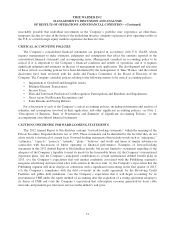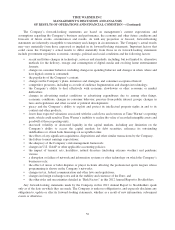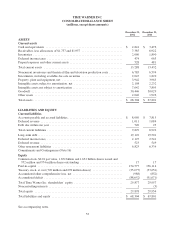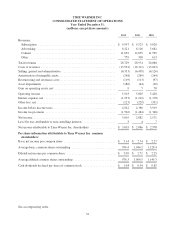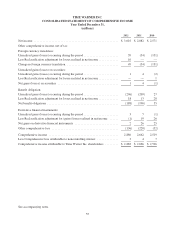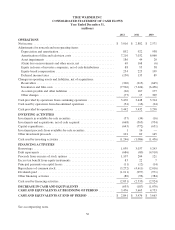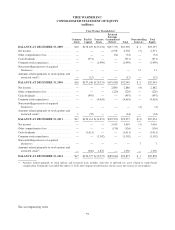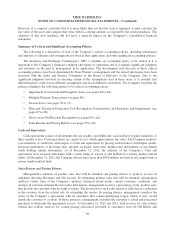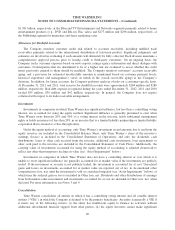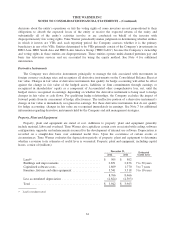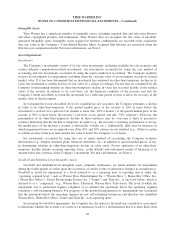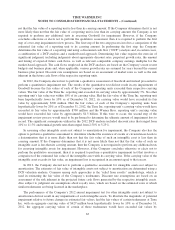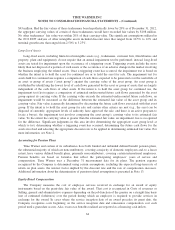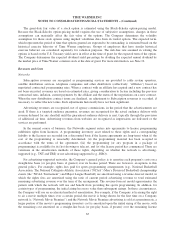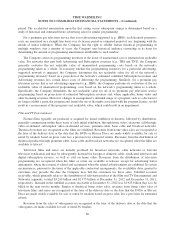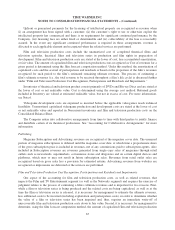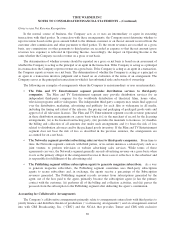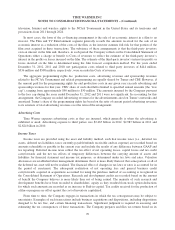Time Magazine 2012 Annual Report Download - page 76
Download and view the complete annual report
Please find page 76 of the 2012 Time Magazine annual report below. You can navigate through the pages in the report by either clicking on the pages listed below, or by using the keyword search tool below to find specific information within the annual report.TIME WARNER INC.
NOTES TO CONSOLIDATED FINANCIAL STATEMENTS – (Continued)
$1.381 billion, respectively, at the Film and TV Entertainment and Networks segments primarily related to home
entertainment products (e.g., DVD and Blu-ray Disc sales) and $275 million and $296 million, respectively, at
the Publishing segment for magazines and direct marketing sales.
Allowance for Doubtful Accounts
The Company monitors customer credit risk related to accounts receivable, including unbilled trade
receivables primarily related to the international distribution of television product. Significant judgments and
estimates are involved in evaluating if such amounts will ultimately be fully collected. Each division maintains a
comprehensive approval process prior to issuing credit to third-party customers. On an ongoing basis, the
Company tracks customer exposure based on news reports, ratings agency information and direct dialogue with
customers. Counterparties that are determined to be of a higher risk are evaluated to assess whether the credit
terms previously granted to them should be modified. The Company monitors customers’ accounts receivable
aging, and a provision for estimated uncollectible amounts is maintained based on customer payment levels,
historical experience and management’s views on trends in the overall receivable agings at the Company’s
divisions. In addition, for larger accounts, the Company performs analyses of risks on a customer-specific basis.
At December 31, 2012 and 2011, total reserves for doubtful accounts were approximately $284 million and $280
million, respectively. Bad debt expense recognized during the years ended December 31, 2012, 2011 and 2010
totaled $55 million, $30 million and $42 million, respectively. In general, the Company does not require
collateral with respect to its trade receivable arrangements.
Investments
Investments in companies in which Time Warner has significant influence, but less than a controlling voting
interest, are accounted for using the equity method. Significant influence is generally presumed to exist when
Time Warner owns between 20% and 50% of a voting interest in the investee, holds substantial management
rights or holds an interest of less than 20% in an investee that is a limited liability partnership or limited liability
corporation that is treated as a flow-through entity.
Under the equity method of accounting, only Time Warner’s investment in and amounts due to and from the
equity investee are included in the Consolidated Balance Sheet; only Time Warner’s share of the investee’s
earnings (losses) is included in the Consolidated Statement of Operations; and only the dividends, cash
distributions, loans or other cash received from the investee, additional cash investments, loan repayments or
other cash paid to the investee are included in the Consolidated Statement of Cash Flows. Additionally, the
carrying value of investments accounted for using the equity method of accounting is adjusted downward to
reflect any other-than-temporary declines in value (see “Asset Impairments” below).
Investments in companies in which Time Warner does not have a controlling interest or over which it is
unable to exert significant influence are generally accounted for at market value if the investments are publicly
traded. If the investment or security is not publicly traded, the investment is accounted for at cost. Unrealized
gains and losses on investments accounted for at market value are reported, net of tax, in Accumulated other
comprehensive loss, net, until the investment is sold or considered impaired (see “Asset Impairments” below), at
which time the realized gain or loss is included in Other loss, net. Dividends and other distributions of earnings
from both market-value investments and investments accounted for at cost are included in Other loss, net, when
declared. For more information, see Notes 3 and 4.
Consolidation
Time Warner consolidates all entities in which it has a controlling voting interest and all variable interest
entities (“VIEs”) in which the Company is deemed to be the primary beneficiary. An entity is generally a VIE if
it meets any of the following criteria: (i) the entity has insufficient equity to finance its activities without
additional subordinated financial support from other parties, (ii) the equity investors cannot make significant
60



